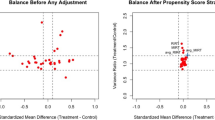Abstract
Described a new class of nonparametric regression procedures called generalized additive models (Hastie and Tibshirani, 1991) for assessing intervention effects in mental health preventive field trials. Such models are often better than analysis of covariance models for examining intervention effects adjusted for one or more baseline characteristics and for assessing potential interactions between the intervention and baseline characteristics. Because of these advantages, generalized additive models are important tools analysts should consider in evaluating preventive field trials. We apply generalized additive models as well as more standard linear models to data from a preventive trial aimed at improving mental health and school performance outcomes through a universal intervention in first and second grades. Practical guidance is given to researchers regarding when generalized additive models would be beneficial.
Similar content being viewed by others
References
Bloom, B. S. (1964).Stability and change in human characteristics. New York: Wiley.
Breiman, L., Friedman, J. H., Olshen, R. A., and Stone, C. J. (1984).Classification and Regression trees. Monterey, CA: Wadsworth & Brooks/Cole.
Brown, C. H. (1991). Principles for Designing Universal and Targeted Intervention Studies. Proceedings of the Second National Conference on Prevention Research, National Institute of Mental Health, Washington, D.C.
Brown, C. H. (1993). Statistical methods for preventive trials in mental health.Statistics in Medicine, 12, 289–300.
Clark, L. A. & Pregibon, D. (1992). Tree-based models. In J. M. Chambers and T. J. Hastie (Eds.),Statistical models in S. Pacific Grove, CA.: Wadsworth & Brooks/Cole.
Cleveland, W. S. (1979). Robust locally weighted regression and smoothing scatterplots.Journal of the American Statistical Association, 74, 829–836.
Cook, T. D. & Campbell, D. T. (1979).Quasi-experimentation: Design and Analysis Issues for Field Settings. Boston: Houghton Mifflin.
Dolan, L., Kellam, S., Brown, C. H., et al. (1993). The short-term impact of two classroom based preventive intervention trials on aggressive and shy behaviors and poor achievement.Journal of Applied Developmental Psychology, 14, 317–345.
Draper, N., & Smith, H. (1981).Applied Regression Analysis (2nd ed.). New York: John Wiley.
Gordon, R. S. (1983). An operational classification of disease prevention.Public Health Reports, 98, 107–109.
Hastie, T., and Tibshirani, R. (1986). Generalized additive models.Statistical Science 1, 297–318.
Hastie, T., and Tibshirani, R. (1991).Generalized additive models. London: Chapman and Hall.
Hastie, T. (1992). Generalized additive models. In Chambers and T. J. Hastie (Eds.),Statistical models in S. Pacific Grove, CA: Wadsworth & Brooks/Cole Advanced Books & Software.
Heimendinger, J., & Laird, N. M. (1983). Measuring the effect of an intervention.Evaluation Review, 7, 80–95.
Kellam, S. G., Branch, J. D., Agrawal, K. C., and Ensminger, M. E. (1975).Mental health and going to school: The Woodlawn program of assessment, early intervention, and evaluation. Chicago: University of Chicago Press.
Kellam, S G., Brown, C. H., Rubin, B. R. & Ensminger, M. E. (1983). Paths leading to teenage psychiatric symptoms and substance use: Developmental epidemiological studies in Woodlawn. In S. B. Guze, F. J. Earls, and J. E. Barrett (Eds.),Childhood psychopathology and development. New York: Raven Press.
Kellam, S. G., Werthamer-Larsson, L., Dolan, L., Brown, C. H., Mayer, L., Rebok, G., Anthony, J., Laudolff, J., Edelsohn, G., & Wheeler, L. (1991). Developmental epidemiologically-based preventive trials: Baseline modeling of early target behaviors and depressive symptoms.American Journal of Community Psychology, 19, 563–584.
Laird, N. M. (1983). Further comparative analyses of pretest-posttest research designs.American Statistician, 37, 329–330.
Lorion, R. P., Price, R. H., & Eaton, W. W. (1989). The prevention of child and adolescent disorders: From theory to research. In D. Shaffer, I. Philips, and N. B. Enzer (Eds.),The prevention of Mental disorders, alcohol, and other drug use in children and adolescents—OSAP prevention Monograph—2. DHHS Publication No. (ADM) 89-1646. Rockville, MD: Office of Substance Abuse Prevention.
Price, R., van Ryn, M., & Vinokur, A. D. (1992). Impact of a preventive job search intervention on the likelihood of depression among the unemployed.Journal of Health and Social Behavior, 33, 158–167.
Author information
Authors and Affiliations
Rights and permissions
About this article
Cite this article
Brown, C.H. Analyzing preventive trials with generalized additive models. Am J Commun Psychol 21, 635–664 (1993). https://doi.org/10.1007/BF00942175
Issue Date:
DOI: https://doi.org/10.1007/BF00942175




